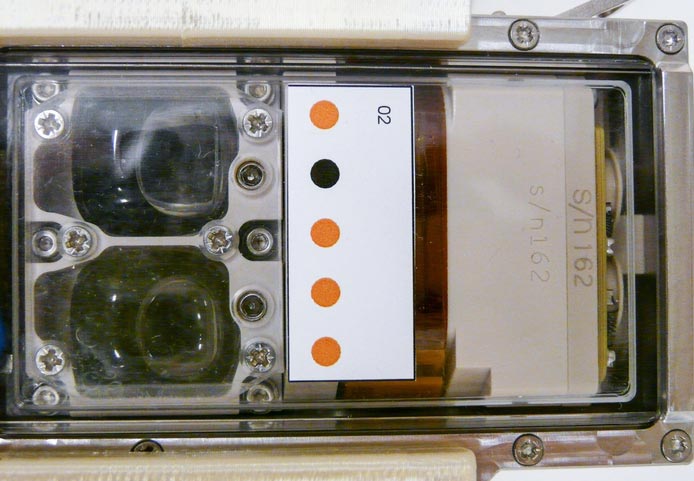Researchers successfully biomine vanadium aboard the space station

Preflight imagery of the two culture chambers of a single experimental unit in the Biorock experiment. The purpose of the Biorock investigation was to examine the effects of altered gravity on the rock/microbe/liquid system as a whole.
Image Courtesy of ESA
For centuries, humans have mined materials to build the tools we use every day, from batteries and cell phones to airplanes and refrigerators. While the process of obtaining these important minerals used to rely entirely on heavy machinery, fire, and human labor, scientists have learned how to harness the natural power of microbes to do some of the work.
This process, called biomining, has become common as a cost efficient and environmentally friendly way to obtain the metals around us in nature. As humans plan expeditions deeper into space, biomining offers a way to obtain needed materials for use on other planetary bodies rather than transporting them from Earth.
In 2019, the ESA (European Space Agency) Biorock investigation conducted aboard the International Space Station demonstrated how microbes can extract rare Earth elements from basalt in space; basalt is a common rock on the Moon and Mars. The team has now shown that microbes can not only mine elements in space, but some microbes may also perform even better under such altered gravitational conditions. In a paper published in Frontiers in Microbiology, Biorock researchers observed an increase of vanadium biomining by as much as 283% under reduced gravity conditions. These results show that biomining may be possible on a large scale in space, extracting elements that humans need to sustain themselves independent of Earth.
Vanadium is an element commercially added to steel to fabricate high strength, corrosion-resistant materials that could be used in buildings, tools, and construction processes on other planets. “Mining is a necessary part of civilization, and it has been going on since people first started settling in villages and cities,” says Charles Cockell, Biorock principal investigator and professor at the UK Centre for Astrobiology at the University of Edinburgh.
Using microbes to do that mining provides advantages over common chemical methods of extracting elements from soil. “Chemical methods of remediation can be very damaging, whereas bioremediation and bioleaching is environmentally friendly, and produces fewer toxins,” Cockell says. “It is low energy demand. You give the microbes some food, and they go about their business of mining.”
Biomining with microbes also has the advantage of being compact, which is convenient for deep space exploration in which space for materials is limited when launching from Earth. But whether this process would work in microgravity was uncertain.
“Microgravity has an effect on bulk fluids, and there is no convection or sedimentation in microgravity,” says Cockell. Because of this effect, the team suspected that altered gravitational conditions might negatively influence biomining by limiting the interactions of microbes of the same species, preventing the mixing of microbes in fluid.
To test whether microbes could biomine vanadium in altered gravitational conditions, the team filled a KUBIK incubator on the space station with liquid growth media, a mixture of nutrients designed to support the growth of microorganisms. The team then grew selected microbes known to break down rocks under microgravity and simulated lunar and Martian gravity conditions. The researchers also supplied the microbes with basalt, a constituent of the lunar and Martian surfaces.
The results were promising. “We were surprised gravity did not have an effect,” says Cockell, “But we think the reason is that for the period of the experiment, 21 days, the microbes were able to grow to their maximum concentration, even in the absence of sedimentation or convection on the space station. Therefore, they were able to mine in the same way, even in different gravity conditions.”
As we learn more about the microbes on Earth, we may discover many that are good candidates for biomining. Scientists currently are doing experiments in the lab to understand the mechanisms behind mining interactions and how these microbes do what they do.
While Biorock’s results provide evidence for the feasibility of biomining in space on the microscopic scale, it could help scientists learn how to make biomining feasible on a macroscale as well. “Right now, the bioreactors are very small. When we are using these bioreactors on a larger industrial scale, what would the effectiveness be on the surface of an asteroid?” Cockell says. “These results will help us answer the mechanisms behind biomining and develop useful technology for Earth.”
For daily updates, follow @ISS_Research, Space Station Research and Technology News, or our Facebook. For opportunities to see the space station pass over your town, check out Spot the Station.
Media Contact
Leah Cheshier
NASA/Johnson Space Center
leah.d.cheshier@nasa.gov
Office: 281-483-5111
All latest news from the category: Life Sciences and Chemistry
Articles and reports from the Life Sciences and chemistry area deal with applied and basic research into modern biology, chemistry and human medicine.
Valuable information can be found on a range of life sciences fields including bacteriology, biochemistry, bionics, bioinformatics, biophysics, biotechnology, genetics, geobotany, human biology, marine biology, microbiology, molecular biology, cellular biology, zoology, bioinorganic chemistry, microchemistry and environmental chemistry.
Newest articles

Superradiant atoms could push the boundaries of how precisely time can be measured
Superradiant atoms can help us measure time more precisely than ever. In a new study, researchers from the University of Copenhagen present a new method for measuring the time interval,…

Ion thermoelectric conversion devices for near room temperature
The electrode sheet of the thermoelectric device consists of ionic hydrogel, which is sandwiched between the electrodes to form, and the Prussian blue on the electrode undergoes a redox reaction…

Zap Energy achieves 37-million-degree temperatures in a compact device
New publication reports record electron temperatures for a small-scale, sheared-flow-stabilized Z-pinch fusion device. In the nine decades since humans first produced fusion reactions, only a few fusion technologies have demonstrated…





















